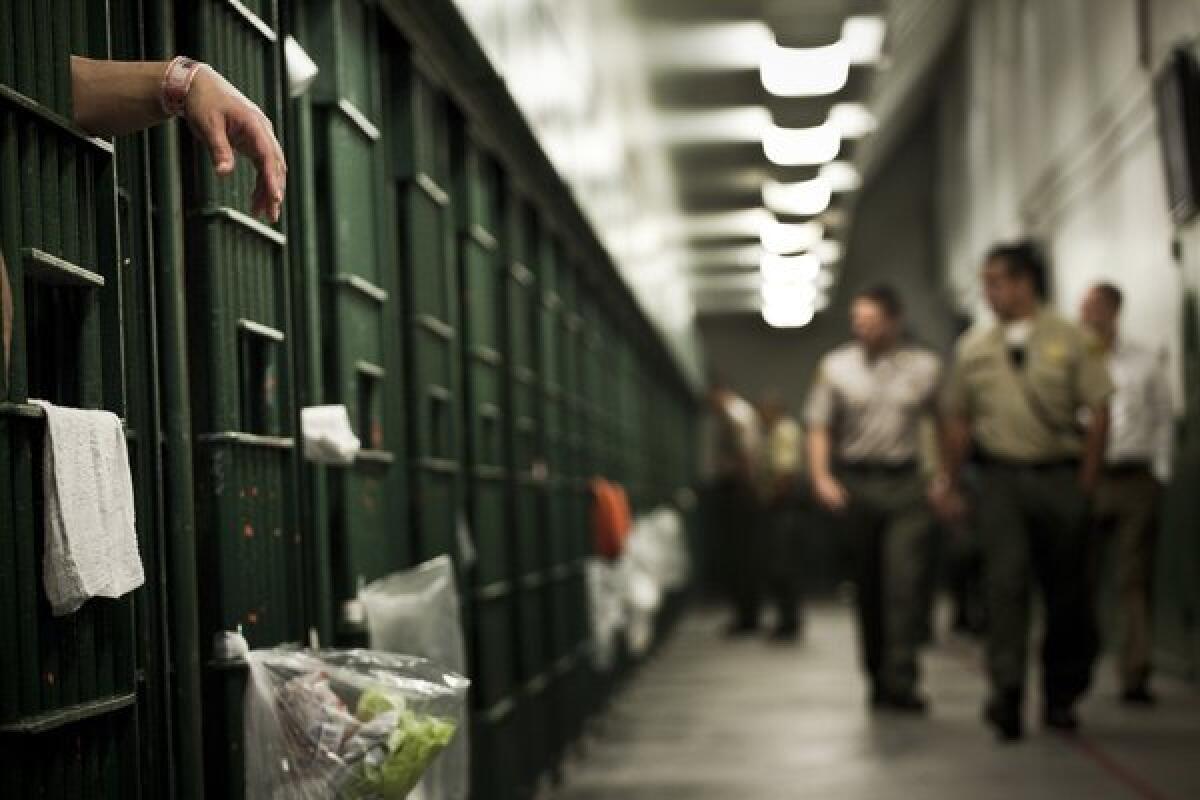Editorial: 2019 was the year L.A. County finally said ‘no’ to new jails

- Share via
What should be a responsible politician’s approach to an aging, poorly designed, dungeon-like men’s jail that endangers inmates and law enforcement personnel alike? How should officials deal with an exploding population of mentally ill men who are in desperate need of treatment but are held in jail because they have been accused of crimes? What is to be done about an overcrowded women’s jail that was built for men and was not set up for young incarcerated mothers to receive visits from their children?
For years, the answers for Los Angeles County supervisors seemed plain, if uninspiring: Tear down Men’s Central Jail in downtown L.A. Move the general inmate population into the adjacent Twin Towers jail, which now houses mentally ill inmates but offers insufficient clinical space. Build a new state-of-the-art treatment-oriented jail for the mentally ill. Rebuild and reopen a shuttered facility in Lancaster and turn it into a new campus-like women’s jail.
Seen through a particular lens, all these moves had enough of a veneer of progress that the supervisors responsible for carrying them out could tell themselves they were being progressive. The new jails would be more humane and better designed. Mental health treatment would be better. Inmates, sheriff’s deputies, physicians, nurses and visitors would be safer. And besides, funding was available from a state program and from local financing.
But jails were still jails, and not an ideal place for mental health treatment or rehabilitation. Supervisors moved forward but more out of resignation than enthusiasm. Contracts were signed, and builders were engaged.
Outside the jails, family members of inmates met their counterparts — other families with incarcerated loved ones. They shared stories of mistreatment, indignities and injustice. They organized, and they successfully advocated for civilian oversight of the Sheriff’s Department, which runs the jails.
And they fought the jail replacement plans, which they argued were merely an expansion of incarceration at the expense of medical treatment and social services, which were the proper response to criminal charges.
They joined with individuals and organizations of disparate backgrounds and experience. The ACLU of Southern California had long criticized the building of new jails and had pushed instead for diversion, out of the criminal justice system entirely, of people dealing with mental illness or who otherwise didn’t belong behind bars.
Los Angeles artist, activist and organizer Patrisse Cullors, in her 2017 book written with Asha Bandele, “When They Call You a Terrorist,” told of her brother and his experience with a broken mental health system, abusive police, cruel jails. The narrative wove together strands that might seem unrelated to people who have not been through the criminal justice system but are all too obvious to people who have. Mental illness. Homelessness. Incarceration. Racism.
Jails are crowded with mentally ill people because states including California closed mental hospitals over several decades beginning in the 1960s without building out the system of community-based mental-health care they had promised. Jail populations are disproportionately black and Latino, in part because of a criminal justice system laced with overly punitive policies that prey on poverty and sentences that punish multiple generations. Building new jails — even ostensibly more humane ones — may sometimes be unavoidable, but it consumes resources that could otherwise be used for correcting the problems and improving lives.
This year — 2019 — was the year that the Board of Supervisors got the message.
In January, as the supervisors were due to move forward on the women’s jail at the Mira Loma facility in Lancaster, they instead said, “No.”
In February, when they were expected to move forward with the Consolidated Correctional Treatment Facility — the jail to treat the mentally ill that was meant to replace the decrepit Men’s Central Jail — they said, “No.” They would build a psychiatric hospital on the site instead. In August, they said “no” to that as well, after activists argued that a locked hospital on the grounds of the jail would be a jail by another name.
The supervisors convened a planning group to present a proposal for alternatives to incarceration, made up not just of attorneys and academics but also of activists and, crucially, people who have lived through and survived the criminal justice system from the inside.
As the proposals come before the board, the coming year will test whether the county’s historic shift from incarceration to a system based on care — mental health care, medical care, reentry services, housing, peer support — is achievable and affordable, and whether it can prevent crime, reduce recidivism and repair broken communities. Moving forward carries a substantial political risk for the supervisors, but to their credit they appear to have embraced the challenge.
More to Read
A cure for the common opinion
Get thought-provoking perspectives with our weekly newsletter.
You may occasionally receive promotional content from the Los Angeles Times.










